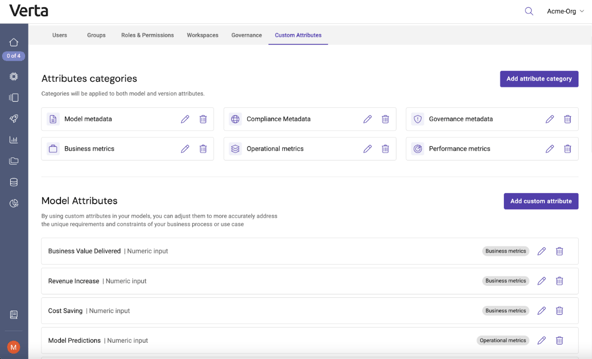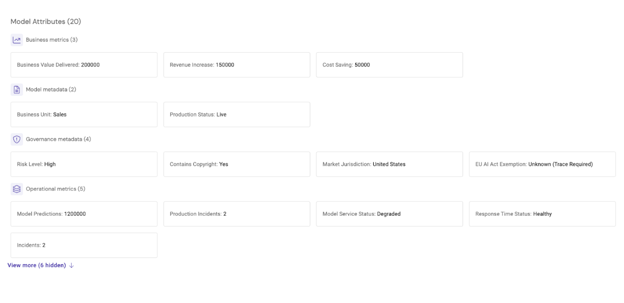
Custom attributes is a unique feature of Verta’s model catalog that lets users define the different kinds of metadata they want to capture about models and model versions. After launching custom attributes several months ago, the feedback has been overwhelmingly positive—and users wanted even more bells and whistles! So, we’re following up with several exciting new enhancements:
- Categories so that you can organize your custom attributes
- New types of custom attributes
- The ability to audit when an attribute was last updated and by whom
Why are custom attributes important?
A model catalog is a great way to create transparency and visibility into ML efforts across your entire organization, but only if you can customize it to your needs. Every organization has a different way of representing models internally, so a cookie-cutter catalog just won’t work.
In addition, the model catalog needs to serve different stakeholders—who naturally want different kinds of information. For example, governance teams may be looking for model risk and model audit information, while data scientists will care more about model performance.
Custom attributes draw inspiration from highly configurable enterprise products like JIRA and Salesforce, resulting in a catalog that’s powerful and flexible enough to serve as the central source of truth for all models at your organization.
What we’ve added
Feedback for custom attributes has been very positive so far. In fact, we noticed that the demand for custom attributes was even bigger than we initially anticipated—leading us to add the following new features.
Categories
One thing that stood out during user testing was that there are different user personas who use the model catalog with their own distinct model documentation needs:
- Governance and risk teams often track as many as 50 different metrics across various tools, and want to use Verta’s model catalog as a single source of truth.
- Business users may look for specific bottom-line metrics like cost and revenue.
- Data science and product teams are interested in model performance metrics like accuracy, product incidents, and IT and operational risks.
When every team has many metrics they want to add, it becomes hard for a single user to discover the things they care about. To solve this, we now let you create custom attribute categories to divide model attributes into groups in the UI. This makes it simple for someone to find the metrics they need without getting lost or overwhelmed.

Model attributes are now grouped by categories in the UI. You can define any categories that make sense for your business.
Any Verta administrator creates categories and chooses the icon to use in the UI. Custom attributes can then be easily mapped to categories.
Adding a new attribute category and associating a model attribute with that category.
New types of custom attributes
Based on user feedback, we also decided to give you even more options when it comes to creating different kinds of custom attributes. Here is the full list of attribute types that are now available:
- Custom list: Define a list of values, from which users can select one or more.
- List of users: Select a user from a list.
- List of groups: Select a group configured in your organization from a list.
- Short text input: Enter up to 250 characters.
- Long text input: Enter up to 2500 characters, for longer descriptions.
- Numeric value: Track stats like accuracy or incidents.
Audit trails (Source)
It’s very important for people to know where information is sourced, so they know that they can trust the information in the catalog. If it’s something like model risk, is it coming from a tool you rely on like Archer? When was it last updated?
To ensure this transparency, we’ve added important audit trail information to custom attributes. Every attribute that gets updated can now capture where it’s coming from, when it was last updated, and who updated it. Admins can make the source a required field, which means an attribute can’t be updated without providing this information.
When you hover over a custom attribute, you’ll see source information. The source can be text or a hyperlink.
Behind the scenes, Verta’s APIs can connect your model catalog to different third-party systems and automatically ingest information for custom attributes. This will populate the source automatically, too. Please chat with us to learn more about how to enable API integrations for your catalog.
We’ve now made custom attributes more aligned with different user groups, more discoverable, and more trustworthy. This is part of our commitment to creating a fully-featured UX that works for everyone who needs access to high-quality model documentation across your organization. Please check out the custom attribute documentation to learn even more.
Want to give Verta a try? You can sign up for free today.
Subscribe To Our Blog
Get the latest from Verta delivered directly to you email.



